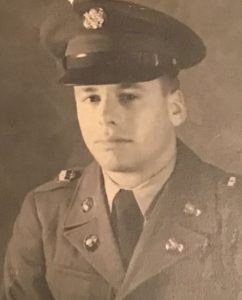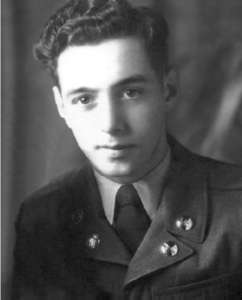William Kenneth Holland, age 21, from Ohio, Hamilton county.
Service era: Korea
Date of death: Monday, June 11, 1951
Death details: On July 5, 1950, Task Force Smith, the first U.S. ground element to engage North Korean People’s Army (NKPA) troops, was defending a position north of Osan, South Korea. The Task Force’s goal was to delay enemy forces by blocking their movement down the road south from Suwon to Taejon, which was a major avenue of advance for the NKPA. That morning, the Task Force was engaged by a column of enemy tanks. The anti-tank weapons that the infantrymen employed were ineffective, and a large number of tanks broke through their position. Task Force Smith was forced to withdraw to the south, suffering heavy casualties in the process. Corporal William Kenneth Holland, who joined the U.S. Army from Ohio, served with M Company, 3rd Battalion, 21st Infantry Regiment, 24th Infantry Division. His unit was part of Task Force Smith, and he was captured by enemy forces on July 5. He was forced to march north to the Apex prison camps, and died of malnutrition and dysentery at the camp at Chunggang-jin on June 11, 1951. Although he was buried nearby, his remains were not identified among those returned to U.S. custody after the ceasefire. Today, Corporal Holland is memorialized on the Courts of the Missing at the National Memorial Cemetery of the Pacific.
Source: National Archives, Defense POW/MIA Accounting Agency

 Death details: On July 5, 1950, Task Force Smith, the first U.S. ground element to engage North Korean People’s Army (NKPA) troops, was defending a position north of Osan, South Korea. The Task Force’s goal was to delay enemy forces by blocking their movement down the road south from Suwon to Taejon, which was a major avenue of advance for the NKPA. That morning, the Task Force was engaged by a column of enemy tanks. The anti-tank weapons that the infantrymen employed were ineffective, and a large number of tanks broke through their position. Task Force Smith was forced to withdraw to the south, suffering heavy casualties in the process. Corporal John Smith Lycan Jr., who joined the U.S. Army from Idaho, served with C Company, 1st Battalion, 21st Infantry Regiment, 24th Infantry Division. His unit was part of Task Force Smith and he was captured by enemy forces on July 5, 1950. He was marched to the Apex prison camps in North Korea. He died of malnutrition on December 31, 1950 at the camp near Hanjang-ni, and was buried by his companions near the compound. His remains have not been recovered or identified among those returned to U.S. custody. Today, Corporal Lycan is memorialized on the Courts of the Missing at the National Memorial Cemetery of the Pacific.
Death details: On July 5, 1950, Task Force Smith, the first U.S. ground element to engage North Korean People’s Army (NKPA) troops, was defending a position north of Osan, South Korea. The Task Force’s goal was to delay enemy forces by blocking their movement down the road south from Suwon to Taejon, which was a major avenue of advance for the NKPA. That morning, the Task Force was engaged by a column of enemy tanks. The anti-tank weapons that the infantrymen employed were ineffective, and a large number of tanks broke through their position. Task Force Smith was forced to withdraw to the south, suffering heavy casualties in the process. Corporal John Smith Lycan Jr., who joined the U.S. Army from Idaho, served with C Company, 1st Battalion, 21st Infantry Regiment, 24th Infantry Division. His unit was part of Task Force Smith and he was captured by enemy forces on July 5, 1950. He was marched to the Apex prison camps in North Korea. He died of malnutrition on December 31, 1950 at the camp near Hanjang-ni, and was buried by his companions near the compound. His remains have not been recovered or identified among those returned to U.S. custody. Today, Corporal Lycan is memorialized on the Courts of the Missing at the National Memorial Cemetery of the Pacific. Death details: On July 5, 1950, Task Force Smith, the first U.S. ground element to engage North Korean People’s Army (NKPA) troops, was defending a position north of Osan, South Korea. The Task Force’s goal was to delay enemy forces by blocking their movement down the road south from Suwon to Taejon, which was a major avenue of advance for the NKPA. That morning, the Task Force was engaged by a column of enemy tanks. The anti-tank weapons that the infantrymen employed were ineffective, and a large number of tanks broke through their position. Task Force Smith was forced to withdraw to the south, suffering heavy casualties in the process. Sergeant Arthur Macon Jones, who joined the U.S. Army from Maryland, served with C Company, 1st Battalion, 21st Infantry Regiment, 24th Infantry Division. His unit was part of Task Force Smith, and he was captured by enemy forces on July 5, 1950, and marched to a temporary prison compound at Manpo, North Korea. After a brief rest, his group proceeded to the Apex prison camps near the Yalu River; however, SGT Jones was too weak to continue. His companions were forced to leave him, and it is believed that he died at Manpo on October 31. His remains were not identified among those returned to U.S. custody after the ceasefire. Today, Sergeant Jones is memorialized on the Courts of the Missing at the National Memorial Cemetery of the Pacific.
Death details: On July 5, 1950, Task Force Smith, the first U.S. ground element to engage North Korean People’s Army (NKPA) troops, was defending a position north of Osan, South Korea. The Task Force’s goal was to delay enemy forces by blocking their movement down the road south from Suwon to Taejon, which was a major avenue of advance for the NKPA. That morning, the Task Force was engaged by a column of enemy tanks. The anti-tank weapons that the infantrymen employed were ineffective, and a large number of tanks broke through their position. Task Force Smith was forced to withdraw to the south, suffering heavy casualties in the process. Sergeant Arthur Macon Jones, who joined the U.S. Army from Maryland, served with C Company, 1st Battalion, 21st Infantry Regiment, 24th Infantry Division. His unit was part of Task Force Smith, and he was captured by enemy forces on July 5, 1950, and marched to a temporary prison compound at Manpo, North Korea. After a brief rest, his group proceeded to the Apex prison camps near the Yalu River; however, SGT Jones was too weak to continue. His companions were forced to leave him, and it is believed that he died at Manpo on October 31. His remains were not identified among those returned to U.S. custody after the ceasefire. Today, Sergeant Jones is memorialized on the Courts of the Missing at the National Memorial Cemetery of the Pacific.